The strange and curious pantheon of biblical gods and monsters (part 1)
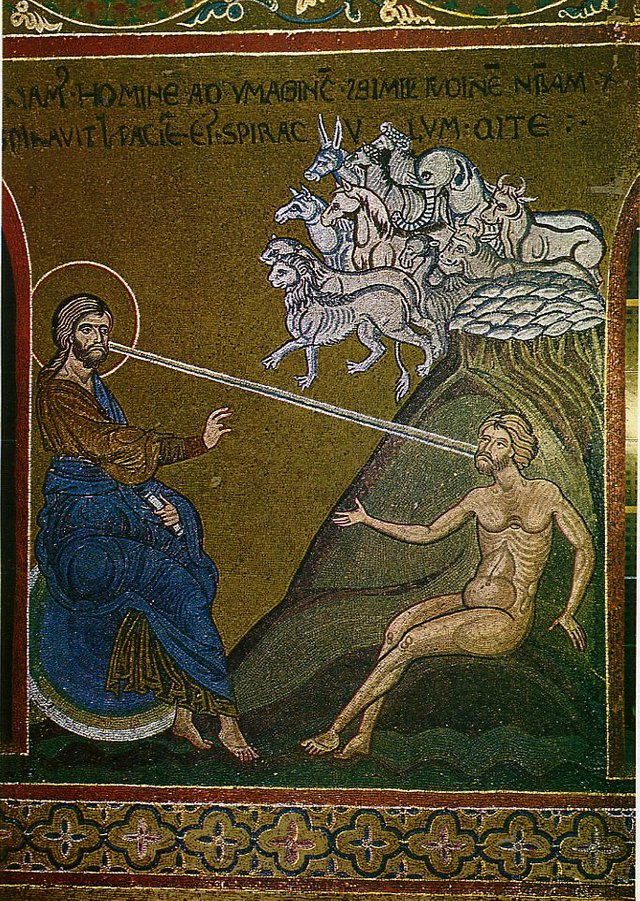
Byzantine Mosaic of the Creation of Adam. Montreal, Canada.
Most people regard the Bible as a play written for a solo supernatural actor - God. From this perspective, just like in the Highlander movie, "there can only be one". This is precisely what one is taught within the conservative religious tradition, whether rabbinical or Christian, that typically tries to downplay the role of angels, demons, or any speculation about polytheism. According to these folks, the Bible is unequivocally monotheistic, and that's the end of it. This premise is then typically contrasted with Greek mythology and other "pagan" traditions that are replete with all kinds of wonderful creatures - centaurs, harpies, sirens, and countless gods of all ranks. As always, the facts of the matter are much more complex, and as a result, quite fascinating.
The Hebrew religion did not emerge in a vacuum, - like most other religions it grew out of a rich dialogue with surrounding cults and religions - those of nearby Levant and the Ancient Egypt being the two most influential sources of appropriated ideas. As a result, the Bible is teeming with hints, references, allusions to outright polytheistic concepts - all right there inside the sacred bastion of monotheism. For some reason this realization has not quite penetrated the popular conception of the Bible. What I would like to do in this post is to take a peek at what lies beneath the familiar, "the obvious", providing a small glimpse of the strange and curious world of biblical gods, monsters, angels and demons.
My main source for this exercise is the excellent "Dictionary of Deities and Demons in the Bible" - a truly phenomenal compilation of over a hundred years' worth of research in the fields of Near Eastern historical, linguistic, hermeneutical and anthropological studies. All quotations from the Bible are from the King James Version (1611) unless otherwise noted. The Hebrew text is given with modern vowel signs, which were not used in the original. So, without further ado, let's dive in!
God - one or two??
The "one God" of the Bible is revealed to have two distinct names - one typically translated as "God" ("El" or "Elohim" [ אֱלֹהִים ] in the original Hebrew, the latter form being a plural (hint?) variant of "El" [ אֱל ] ), while the other name is usually rendered as "LORD" (which stands for the famous tetragrammaton of YHWH [יְהֹוָה] God's "unpronounceable" name). In the conservative circles the two names are understood to be aliases of one another - i.e. fully interchangeable. However, the characteristics associated with each name are quite distinct and are easily traceable through most of the Hebrew Bible. For example, Yahweh has clear anthropomorphic features - he walks in the garden, fashions man out of the ground, appears in visions, wrestles with Jacob, and he is associated with overseeing the nascent nation of Israel. El, on the other hand, appears more abstract, unreachable and transcendent. He is the one who is above and beyond all, he counts and names the stars. Linguistically the two terms are quite disparate; while "El" seems to be of a clear Semitic origin, Yahweh may be actually Egyptian in origin - one of the earliest extra-biblical mentions of the title YHWH was found in the temple built by Amenhotep III c.1400 B.C (see https://en.wikipedia.org/wiki/Shasu) .
The links between the Egyptian and the Hebrew religious systems go way deeper than mere etymology - the story of creation in Genesis 1 has very real parallels with the Egyptian cosmology, specifically the idea that the Demiurge can create the world by power of thought/word alone. A document whose origins go back to the Old Kingdom, known as the Memphite Theology, describes Ptah, the chief god of Memphis, who thinks things in his heart and, as he pronounces them, they spring into being. (See this paper for details).
The duality between El and Yahweh, both in their origin and semantics, had led to the development of the Documentary Hypothesis that postulated multiple sources for the Pentateuch, - based on which "god" predominates in the plot - "J" for the Yahwist source, and "E" for the Elohwist source.
Moreover, the cult of Yahweh and the cult of El have separate geographical regions - El being more prevalent in the north (10 tribes of Israel, with the capital in Samaria, during the divided kingdom) and Yahweh being more "popular" in the South, in Judah, with the capital and center of worship in Jerusalem. The descriptions of El in Ugaritic clay tablets have shown clear parallels between the biblical "God" and the Ugaritic El - the "Father of nations" and the Head of the "divine council" of the gods. Yahweh, on the other hand, seems to resemble the Ugaritic Baal - a younger, more ambitious deity that often gets close and personal with human beings, and has epithets that are consistent both in Ugaritic texts and the Bible, such as "Rider on the clouds".
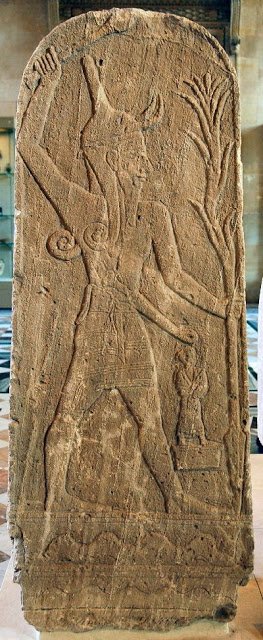
Stele of the thunderbolt-bearing Baal of Ugarit. 1900 BCE. Louvre, France.
Psalm 82 is one of the finest examples of the tension between polytheism and monotheism in the Bible. "God [Elohim] standeth in the congregation of the mighty [El, sometimes tr. as "mighty"], he judgeth among the gods [Elohim]" (Ps. 82:1) What is going on here? How many gods are involved? These questions may be answered by comparing this scene to the Ugaritic "divine council" depictions where El - the Head of the Council received homage from and offered judgement to the other members of the divine pantheon - Baal, Anat, Asherah and others. The parallels are quite striking.
On a slightly more amusing note, did you know that in the Bible it is God who has horns, and not the devil? That's right - the prophet Habbakuk said it, so it must be right - "His [God's] glory covered the heavens, and the earth was full of his praise.And his brightness was as the light; he had horns coming out of his hand: and there was the hiding of his power." (Hab 3:4) Some translations render this as "rays" but that's really side-stepping the issue - the Hebrew word "qeren" is clearly "horns" in 95% of the other usages in Hebrew Bible. Medieval paintings and sculptures of Moses often take this idea a step further in portraying Moses with "horns" as a symbol of his god-likeness.

Michelangelo, Moses - fragment. 1513. San Pietro in Vincoli, Rome, Italy.
Cherub (כְּרוּב)- appearing as early as Genesis 3 where God puts a cherub guard around the tree of life after the Fall of mankind, these creatures are quite mysterious in their origin, description and nature. Most scholars believe that the cherubim are essentially a Hebrew version of a sphinx - a creature widely known both in Egypt and Ancient Mesopotamia. The function of the biblical and a generic Near Eastern sphinx was the same - they were the guardians of the royal/divine throne (or abode, as in Egyptian pyramids). Based on the description of the Solomon's Temple in 1 Kings 6, the cherubim there were 5 meters tall, two-winged and stood above the "Mercy Seat" - the holiest place in the Temple. Thus, one can envision rather ominous creatures, the armed sphinx-like entourage of God's throne. This sounds quite different from Raphael's rendering of cherubs as bored, apathetic kids with wings in his famous Sistine Madonna, pictured below.

Raphael, Fragment from Madonna di San Sisto, 1512. Dresden.
I personally prefer Svyatoslav Roerich's rendering of cherubim (well, maybe it was not specifically a cherub, but an angel nonetheless):
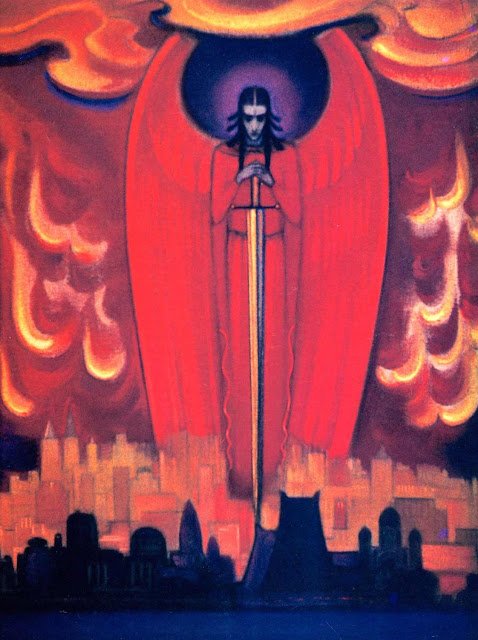
S. Roerich. Humanity, look! 1962. Fragment
Seraph (שָׂרָף) - The most famous scene associated with these creatures is pictured in Isaiah 6:2-3 : "Above it [the throne of God] stood the seraphim: each one had six wings; with twain he covered his face, and with twain he covered his feet, and with twain he did fly. And one cried unto another, and said, Holy, holy, holy, is the LORD of hosts: the whole earth is full of his glory." The word "seraph" is first mentioned in Numbers 21:6 where it is translated "fiery serpents" - a plague that God sent to the Israelite camp as punishment for their apostasy. God then commands Moses to make a bronze "fiery serpent" and put him on a pole (an idol???) so that anyone who looks on it could be saved from the serpents' bites. Literally hundreds of scarab seals from the Middle-Late Bronze Age of Syro-Palestinian region have since been discovered, attesting to the wide circulation of "winged serpents" (uraei). These have also been found throughout Egypt and Phoenicia, and the scholarly consensus is pretty much that the seraphim of the Bible are of the Egyptian origin.
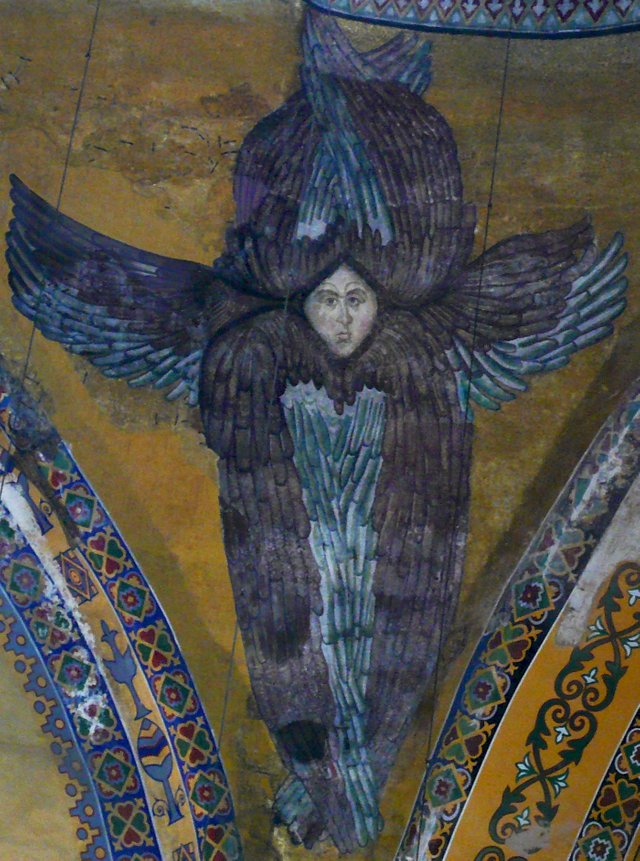
Seraphim as portrayed in Hagia Sophia basilica, Istanbul, Turkey.
Abaddon (אֲבַדּוֹן) - the Hebrew noun literally means "place of destruction" and it is used as a synonym of Hebrew underworld - Sheol. However, in Job 28:22 both Abaddon and Death (see below) appear personified - they can both speak and hear: "Destruction and death say, We have heard the fame thereof with our ears." Thus starts the tradition of a fearsome diving being of destruction which is alluded to in later Hebrew apocryphal writings and makes his way to the Christian tradition in Revelation 9:11 as the "King of Locust": "And they had a king over them, which is the angel of the bottomless pit, whose name in the Hebrew tongue is Abaddon, but in the Greek tongue hath his name Apollyon." Here, in an interesting twist, Abaddon is identified with the Greek Apollyon - i.e. Apollo. This makes sense as Apollo had always been associated with both destruction and healing in the Greek lore. Thus, in a true syncretic fashion of late Hellenism we see the conscious attempt to merge two separate traditions into a single unified concept. This figure has not passed unnoticed in literary tradition. In Mikhail Bulgakov's opus about the modern day Faust, - "Master and Margarita" - we encounter a character named Abaddon as Woland's henchman-assassin who kills an overambitious spy Baron Meigel.

Albrecht Durer, 1497. The Angel with the Key to the Bottomless Pit.
Azazel (עֲזָאזֵל) - the etymology is unclear as the term appears in one place in the Hebrew Bible - in Leviticus 16:8-10, a passage describing a sin offering using a scapegoat (translation of Azazel). The passage is rather cryptic - there are to be 2 goats to be chosen by lots, one for Yahweh, as a sin offering, and one for "scapegoat" (how Azazel is translated) which is not to be killed, but is to be sent off to the wilderness. The key is verse 10 -
"But the goat, on which the lot fell to be the scapegoat[Azazel], shall be presented alive before the LORD, to make an atonement with him, and to let him go for a scapegoat[Azazel] into the wilderness."
Here is how some of the other translations render this:
"but the goat on which the lot fell for Azazel shall be presented alive before the LORD to make atonement over it, that it may be sent away into the wilderness to Azazel." (English Standard Version),
"but the goat on which the lot fell for Aza'zel shall be presented alive before the LORD to make atonement over it, that it may be sent away into the wilderness to Aza'zel." (Revised Standard Version).
The implication is that Azazel is not the goat but the one for whom the goat is meant, a demonic type of being who is being placated by the offering of live animal. Even Gesenius in his conservative Hebrew-Chaldee Lexicon writes, "By this name is I suppose to be understood originally some idol to be appeased by sacrifices". His rendering of Azazel is "averter", similar to LXX (Septuagint) translation which means "to carry away". Similarly, the name Azazel is used by Arabs to denote an evil spirit.
This line of interpretation continues in the Hellenistic period with the apocryphal book of 1 Enoch (for instance in 8:1- Azazel is presented as the Prometheus-style hero who teaches mankind metallurgy, crafts, even the art of make up!) The "goat connection" of the ritual may lie at the heart of the medieval association of the devil with a goat-legged, hoofed creature (see Bibliography, Kulik, 2013). The etymology of the word is unclear, it may be related to the Akkadian "ezezu" which means "to be angry" - something that makes sense in the propitiation rite which seeks to divert God's anger from sin onto a substitute -a scapegoat. The rite itself is of an ancient North Syrian/Mesopotamian origin.
Again, turning to the literary tradition and to Mikhail Bulgakov's "Master and Margarita" (a favorite of mine as you could probably tell by now), one of Woland's entourage is named Azazello, hearkening back to the demonic being that is referenced in the Bible.

Azazello played by Aleksandr Philippenko in Bortko's "Master and Margarita", 2005.
Seirim (שָׂעִיר) - the biblical association of the demonic with goats does not end with Azazel. The word "seirim" (pl. or "seir") which literally means "he-goat", and by implication "hairy" (used of Esau, for instance, in Genesis 27:11), is also used to denote demons, as is clear from Leviticus 17:7"And they shall no more offer their sacrifices unto devils [Seir]...". In Isaiah the word is translated as 'satyrs' in King James Version, so as far as they were concerned, there was no reason why the Bible had to be behind the Greek myths in sporting a satyr or two:
But [when God's judgement visits the place] wild beasts of the desert shall lie there; and their houses shall be full of doleful creatures; and owls shall dwell there, and satyrs [Seirim] shall dance there. And the wild beasts of the islands shall cry in their desolate houses, and dragons in their pleasant palaces: and her time is near to come, and her days shall not be prolonged. (Isaiah 13:21-22)
and in an almost copy-and-paste formulaic fashion in another passage in Isaiah with a similar theme:
And thorns shall come up in her palaces, nettles and brambles in the fortresses thereof: and it shall be an habitation of dragons, and a court for owls. The wild beasts of the desert shall also meet with the wild beasts of the island, and the satyr [Seir] shall cry to his fellow; the screech owl also shall rest there, and find for herself a place of rest. There shall the great owl make her nest, and lay, and hatch, and gather under her shadow: there shall the vultures also be gathered, every one with her mate. (Isaiah 34:13-15)
Dragons, desolate houses, screeching owls, dancing satyrs, wild beasts - if this does not sound like a description of some scene from "Harry Potter", I am not sure what does! LXX translates "seirim" in Isaiah as δαιμόνια - demons. Sic!

The Archangels - Uriel/Sariel, Michael, Gabriel,Raphael. The Hebrew Bible lists several angels by name, among them Michael, who is introduced as angel-protector of Israel and a "prince" (Daniel 10:13,21,12:1) and Gabriel - angel messenger/interpreter (Daniel 8:15-26, 9:21). In the New Testament tradition Gabriel announces to Mary that she is to be the mother of the Christ. According to the Targumim (Jewish rabbinical commentary on the Hebrew Scriptures) , Gabriel and Michael participate in the burial of Moses, described in the closing verses of Deuteronomy. Raphael is mentioned in the Apocryphal book of Tobit, which is considered to be canonical in the Catholic Church, as an angelic physician par excellence (Tobit 12:15), and Uriel/Sariel is described in the apocryphal writings of the Book of Enoch as a star guide and an angelic astrologer (I Enoch 9,20). Incidentally, I Enoch, dated around 100 BCE, is the oldest extant manuscript to list all four archangels by name.
The mention of these angels by name led to the tradition of regarding them as exceptional among other angelic beings - hence, the Greek term "archangel", a super-angel, which appears in the New Testament twice - 1 Thess. 4:16 - "For the Lord himself shall descend from heaven with a shout, with the voice of the archangel..." and in an enigmatic passage in Jude 9: "Yet Michael the archangel, when contending with the devil he disputed about the body of Moses...". All of the angels' names end with "el" - which can mean "god", "divine" or "mighty". For instance, Michael's name means "who is like God?", Gabriel - "God is my warrior", Raphael - "God heals".

El Greco. Annunciation, 1614. Oil on canvas, 291 x 205 cm
Colección Santander Central Hispano, Madrid
Satan (שָׂטָן) - if this word vaguely reminds you of the Arabic "Shaitan"(Iblis), your instincts are serving you well - these are in fact cognates of the same root. The literal meaning of the word is "adversary", "one who opposes" - "..and he shewed me Joshua the high priest standing before the angel of the LORD, and Satan standing at his right hand to resist him" (Zechariah 3:1). The word for "Satan" and the word for "resist" are exactly the same ("sah-tan") in this verse, so one could almost translate it "and there stood the Resistor ...to resist" or "there stood Satan to do what Satan does ". However, the relationship between God and Satan in the Hebrew Bible is not as unequivocal as one might think. They are enemies. Sort of. But then they hang out together, like in the book of Job:
"Now there was a day when the sons of God came to present themselves before the LORD, and Satan also came among them. The LORD said to Satan, “From where do you come?” Then Satan answered the LORD and said, “From roaming about on the earth and walking around on it.” The LORD said to Satan, “Have you considered My servant Job?, etc..." (Job 1:4-6, New American Standard Bible)
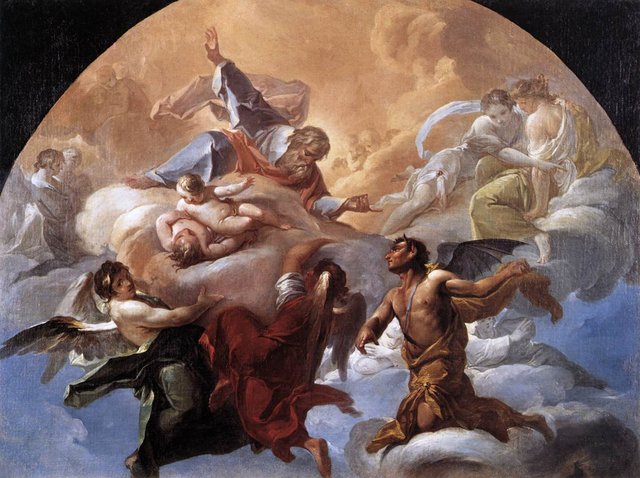
Satan before the Lord. Corrado Giaquinto. 1750. Vatican.
This is odd. How does Satan get to have a tête–à–tête with God in the first place?? Haven't we heard for centuries that nothing impure and evil can come before God?? How does Satan just waltz in there before God like...nothing happened? As you read this passage, it certainly appears that God and Satan are practically pals. "Hey, where have you been? Oh, just hanging out here and there". This does not sound like two sworn enemies to me. But wait, there is more! They make a bet (!), and God is willing to stake people's lives just to prove his "frenemy" Satan wrong! Something is rotten in the state of Denmark...
The answer to this riddle might come from the following passage, a familiar story of Balaam and a talking donkey. Balaam is about to curse Israel, but God sends his angel to prevent him; Balaam is oblivious to the angel, but the donkey is more alert and eventually becomes a talking donkey. Here it goes:
"And God's anger was kindled because he [Balaam] went: and the angel of the LORD stood in the way for an adversary [satan] against him. Now he was riding upon his ass, and his two servants were with him." (Numbers 22:22)
What is Satan in this passage? He is an adversary of Balaam, and a loyal messenger of God. The idea of Satanic revolt is nowhere to be seen. Thus, is Satan in the divine court of the book of Job simply a precocious angel that likes to provoke God's betting streak? Watch out, if you are not careful, you might become a contest ground for the risk-loving angels of heavenly courts!
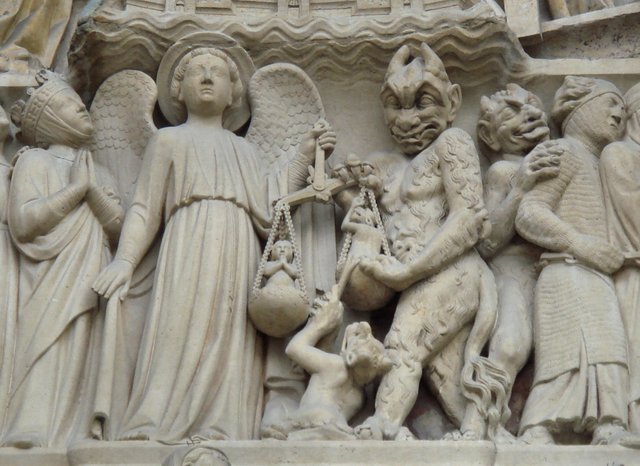
Central Gate, Notre Dame de Paris.
This is it for now, folks. Stay tuned for parts 2 and 3.
Mate, this is a very good article! :) By the way, who is the author of "Dictionary of Deities and Demons in the Bible"? And a suggestion: Put the bibliography in the end of each part. In that way, the people who is curious about this or another theme would look for it in their cities or in internet.
Thanks! I was going to put bibliography section in the final series' post, but you are probably right - it's better to list it at the end of each post, to make it more accessible. Anyways, here is the info on the source you asked about - Dictionary of Deities and Demons in the Bible. Edited by Karel Van Der Toorn, Bob Becking and Pieter W. Van Der Horst. Leiden: Brill/Grand Rapids: Eerdmans. 2nd ed., 1999.
Oh! And I suggest you to consult "Encyclopaedia of Gods and Goddeses, Devils and Demons" by Manfred Lurker, and "History of religions" by Mircea Eliade.
Thanks, I will check them out!
You're welcome!
Thank you so much! :) I will look for it.